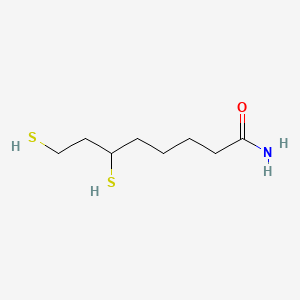| MeSH term | MeSH ID | Detail |
|---|---|---|
| Parkinsonian Disorders | D020734 | 20 associated lipids |
Dihydrolipoamide
Dihydrolipoamide is a lipid of Fatty Acyls (FA) class. Dihydrolipoamide is associated with abnormalities such as Wiskott-Aldrich Syndrome. The involved functions are known as Citric Acid Cycle, Electron Transport, NADH oxidation, Oxidation and Oxidants. Dihydrolipoamide often locates in Mitochondria, Mitochondrial matrix and Chloroplasts. The associated genes with Dihydrolipoamide are Mutant Proteins, Recombinant Proteins, mycothione reductase, Genes, Mitochondrial and alanylproline.
Cross Reference
Introduction
To understand associated biological information of Dihydrolipoamide, we collected biological information of abnormalities, associated pathways, cellular/molecular locations, biological functions, related genes/proteins, lipids and common seen animal/experimental models with organized paragraphs from literatures.
What diseases are associated with Dihydrolipoamide?
Dihydrolipoamide is suspected in and other diseases in descending order of the highest number of associated sentences.
Related references are mostly published in these journals:
| Disease | Cross reference | Weighted score | Related literature |
|---|
Possible diseases from mapped MeSH terms on references
We collected disease MeSH terms mapped to the references associated with Dihydrolipoamide
PubChem Associated disorders and diseases
What pathways are associated with Dihydrolipoamide
There are no associated biomedical information in the current reference collection.
PubChem Biomolecular Interactions and Pathways
Link to PubChem Biomolecular Interactions and PathwaysWhat cellular locations are associated with Dihydrolipoamide?
Visualization in cellular structure
Associated locations are in red color. Not associated locations are in black.
Related references are published most in these journals:
| Location | Cross reference | Weighted score | Related literatures |
|---|
What functions are associated with Dihydrolipoamide?
Related references are published most in these journals:
| Function | Cross reference | Weighted score | Related literatures |
|---|
What lipids are associated with Dihydrolipoamide?
There are no associated biomedical information in the current reference collection.
What genes are associated with Dihydrolipoamide?
Related references are published most in these journals:
| Gene | Cross reference | Weighted score | Related literatures |
|---|
What common seen animal models are associated with Dihydrolipoamide?
There are no associated biomedical information in the current reference collection.
NCBI Entrez Crosslinks
All references with Dihydrolipoamide
Download all related citations| Authors | Title | Published | Journal | PubMed Link |
|---|---|---|---|---|
| Da Sylva TR et al. | Somatic mutations in the mitochondria of rheumatoid arthritis synoviocytes. | 2005 | Arthritis Res. Ther. | pmid:15987486 |
| Tsiveriotis K et al. | Antineutrophil cytoplasmic antibodies testing in a large cohort of unselected greek patients. | 2011 | Autoimmune Dis | pmid:21687647 |
| Porras P et al. | Glutaredoxins catalyze the reduction of glutathione by dihydrolipoamide with high efficiency. | 2002 | Biochem. Biophys. Res. Commun. | pmid:12135599 |
| Park YH and Patel MS | Characterization of interactions of dihydrolipoamide dehydrogenase with its binding protein in the human pyruvate dehydrogenase complex. | 2010 | Biochem. Biophys. Res. Commun. | pmid:20385101 |
| Fischer A et al. | Effect of selenium and vitamin E deficiency on differential gene expression in rat liver. | 2001 | Biochem. Biophys. Res. Commun. | pmid:11444866 |
| McCully V et al. | Resolution of branched-chain oxo acid dehydrogenase complex of Pseudomonas aeruginosa PAO. | 1986 | Biochem. J. | pmid:3085653 |
| Murphy MP | How mitochondria produce reactive oxygen species. | 2009 | Biochem. J. | pmid:19061483 |
| Pedrajas JR et al. | Two isoforms of Saccharomyces cerevisiae glutaredoxin 2 are expressed in vivo and localize to different subcellular compartments. | 2002 | Biochem. J. | pmid:11958675 |
| Molina Portela MP and Stoppani AO | Redox cycling of beta-lapachone and related o-naphthoquinones in the presence of dihydrolipoamide and oxygen. | 1996 | Biochem. Pharmacol. | pmid:8573194 |
| Song J and Jordan F | Interchain acetyl transfer in the E2 component of bacterial pyruvate dehydrogenase suggests a model with different roles for each chain in a trimer of the homooligomeric component. | 2012 | Biochemistry | pmid:22413895 |
| Argyrou A et al. | Catalysis of diaphorase reactions by Mycobacterium tuberculosis lipoamide dehydrogenase occurs at the EH4 level. | 2003 | Biochemistry | pmid:12590611 |
| Argyrou A et al. | The lipoamide dehydrogenase from Mycobacterium tuberculosis permits the direct observation of flavin intermediates in catalysis. | 2002 | Biochemistry | pmid:12463758 |
| Bryk R et al. | Triazaspirodimethoxybenzoyls as selective inhibitors of mycobacterial lipoamide dehydrogenase . | 2010 | Biochemistry | pmid:20078138 |
| Kareyeva AV et al. | Mitochondrial hydrogen peroxide production as determined by the pyridine nucleotide pool and its redox state. | 2012 | Biochim. Biophys. Acta | pmid:22503830 |
| LuÃs PB et al. | Valproic acid metabolites inhibit dihydrolipoyl dehydrogenase activity leading to impaired 2-oxoglutarate-driven oxidative phosphorylation. | 2007 | Biochim. Biophys. Acta | pmid:17706936 |
| Jacobia SJ et al. | Characterization of a missense mutation at histidine-44 in a pyruvate dehydrogenase-deficient patient. | 2002 | Biochim. Biophys. Acta | pmid:11781147 |
| Tyagi TK et al. | Moonlighting protein in Starkeyomyces koorchalomoides: characterization of dihydrolipoamide dehydrogenase as a protein acetyltransferase utilizing acetoxycoumarin as the acetyl group donor. | 2009 | Biochimie | pmid:19383527 |
| Tam TK et al. | In situ regeneration of NADH via lipoamide dehydrogenase-catalyzed electron transfer reaction evidenced by spectroelectrochemistry. | 2012 | Bioelectrochemistry | pmid:22497727 |
| Takahashi T et al. | NADPH-dependent coenzyme Q reductase is the main enzyme responsible for the reduction of non-mitochondrial CoQ in cells. | 2008 | Biofactors | pmid:19096101 |
| Nordman T et al. | Regeneration of the antioxidant ubiquinol by lipoamide dehydrogenase, thioredoxin reductase and glutathione reductase. | 2003 | Biofactors | pmid:14695919 |
